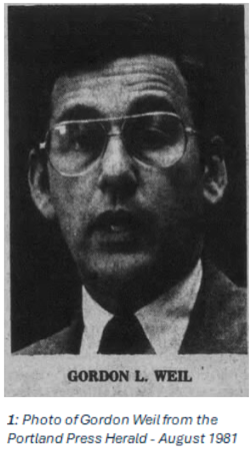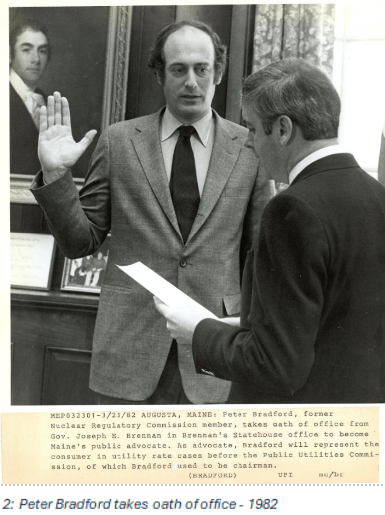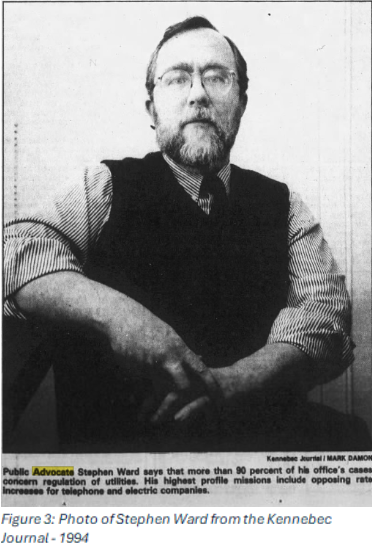The Office of The Public Advocate (OPA) was founded in 1981 during Gov. Joseph E. Brennan’s tenure. With the passage of L.D. 1673 (H.P. 1578) – An Act to Create the Public Advocate to Represent the Interests of Utility Customers, Maine ratepayers gained an advocate, someone who went to work every day with their best interests at heart.
 L.D. 1673 was emergency legislation enacted in the face of several major proceedings pending at the Public Utilities Commission (PUC). This was “at a time during which there was substantial public concern and distrust as to whether the Public Utilities Commission was protecting the interests of the public” (L.D. 1673). The legislation was also urgent for other reasons. For example, at this time funding typically allocated to advocacy groups that represented the “using and consuming public” in Maine was endangered due to federal budget cuts. The creation of the OPA also relieved some of the responsibility of other public interest intervenors including the Attorney General.
L.D. 1673 was emergency legislation enacted in the face of several major proceedings pending at the Public Utilities Commission (PUC). This was “at a time during which there was substantial public concern and distrust as to whether the Public Utilities Commission was protecting the interests of the public” (L.D. 1673). The legislation was also urgent for other reasons. For example, at this time funding typically allocated to advocacy groups that represented the “using and consuming public” in Maine was endangered due to federal budget cuts. The creation of the OPA also relieved some of the responsibility of other public interest intervenors including the Attorney General.
Since its creation, the OPA has represented consumers on a variety of issues. The primary focus of the office has always been representing ratepayers of regulated public utilities such as electricity, natural gas, telecommunications, and water. Over the course of its history the OPA has also focused on a variety of other areas. In the early 1980s, the OPA was responsible for representing milk consumers before the Maine Milk Commission, due to the expressed importance of milk to the health of children and adults in Maine, and a concern over the minimum price set for milk by the Maine Milk Commission at that time. Another example is emergency legislation in the late 1980’s which directed the OPA to represent consumers of workers’ compensation insurance before the Superintendent of Insurance. This continued to be part of the OPA’s duties for nearly 10 years. In another example, at the beginning of Stephen Ward’s tenure the Public Advocate was designated as the Governor’s representative in addressing the federal low-level radioactive waste mandates, leading to successful negotiations on the terms of a disposal compact with Texas and with Vermont.
Employees of the Office have served on numerous state boards and commissions, such as the Maine Low-level Radioactive Waste Disposal Commission, the Telecommunications Relay Services Council, the Federal Communications Commission’s Rural Taskforce, and the Blue Ribbon Commission on Internet Access. More recently, the OPA has organized and staffed the Electric Ratepayer Advisory Council.
 In 2019, the legislature passed L.D. 1181 (H.P. 0855) - An Act to Reduce Electricity Costs through Non-wires Alternatives (NWA) providing greater focus on alternatives to increased utility investment in poles and wires. Under the Act, the OPA hires and supervises the NWA Coordinator for the state and presents to the PUC for its consideration cost effective alternatives to specific capital projects proposed by the Transmission and Delivery (T&D) utilities.
In 2019, the legislature passed L.D. 1181 (H.P. 0855) - An Act to Reduce Electricity Costs through Non-wires Alternatives (NWA) providing greater focus on alternatives to increased utility investment in poles and wires. Under the Act, the OPA hires and supervises the NWA Coordinator for the state and presents to the PUC for its consideration cost effective alternatives to specific capital projects proposed by the Transmission and Delivery (T&D) utilities.
Through the years, the Office has consistently protected consumers from higher costs. In 1983, soon after the OPA was created, the Public Advocate included the following statement in its Annual Report to the Legislature:
“... consider the very different recommendations of the Public Advocate and the advocacy staff in the most recent Central Maine Power Company and New England Telephone cases. In the former case, the Public Advocate recommended an increase of approximately $2.5 million, or nearly one-tenth of the amount recommended by the PUC staff. In the latter case, the Public Advocate’s recommendation was approximately $10 million less than that recommended by the [PUC] staff.”
Each year, the OPA saves consumers thousands of dollars. Since 1988, the Office has saved ratepayers over $1 billion.
Despite this record, there have been several attempts to merge or eliminate the Office of the Public Advocate. The first occurred in 1983, as there was some concern that the OPA was duplicative of the PUC and specifically of the PUC advocacy staff. In response, filings were made by both the PUC advocacy staff and the Public Advocate to clarify the importance of their independence from one another.
Later, in the early 1990s, there were again arguments to merge the OPA with other departments. At this time, there was a Special Commission on Government Restructuring, and many wanted to see an Office of Advocacy that would combine staff from many different agencies and departments including the OPA. In 1991, the Public Advocate, Stephan G. Ward, addressed the Commission to express his objections, which included inadequate oversight and a concern that combining advocacy work under one umbrella might mean losing some advocacy workers.
 In 1999, the idea of incorporating the OPA into the Office of the Attorney General was discussed and dismissed. Then, in 2003, there was a bill in the Legislature which would have abolished the OPA. This bill was actively opposed by the Telephone Association of Maine and many others.
In 1999, the idea of incorporating the OPA into the Office of the Attorney General was discussed and dismissed. Then, in 2003, there was a bill in the Legislature which would have abolished the OPA. This bill was actively opposed by the Telephone Association of Maine and many others.
The office itself has shifted in structure over the years. Since 1981, there has consistently been someone in the position of Public Advocate and there has always been supporting staff which includes attorneys with the appropriate expertise in energy law and regulation. Initially, the Public Advocate was appointed by and served at the pleasure of the Governor. While the Public Advocate is still appointed by the Governor, because of 2009 legislation, the Public Advocate now serves a 4-year term.
The size and location of the office have also shifted over the years. Originally, the office was in Augusta at the State House complex. Eventually, in 1999, the office moved to its current location in downtown Hallowell.
The office has always been made up of a small team. Early on, there were typically seven total staff members. In 1999, the office reorganized to create many of the positions that exist today. At that time, three new positions were added to the staff. Despite this, in 2003, there were only five people working in the office. By 2007, that number had risen to 10. There was some fluctuation in the number of staff in the next few years as well as further reorganization that removed the position of the Clerk and added the roles of Consumer Advocate and eventually Legal Assistant. Today, the OPA has a staff of eleven people.
The OPA is funded by a special assessment on every regulated Maine utility. Since 2000 the OPA budget has doubled to its 2024 level of approximately $3.7M.
Public Advocates
- Gordon Weil 1981-1982
- Peter Bradford 1982-1983
- Paul Fritzsche 1983-1986
- Stephen G. Ward 1986-2007
- Richard Davies 2007-2013
- Timothy R. Schneider 2013-2017
- Barry J. Hobbins 2017-2022
- William S. Harwood 2022-2025
- Heather B. Sanborn 2025-present